'Metal Gear Solid V: The Phantom Pain' is a tale of revenge
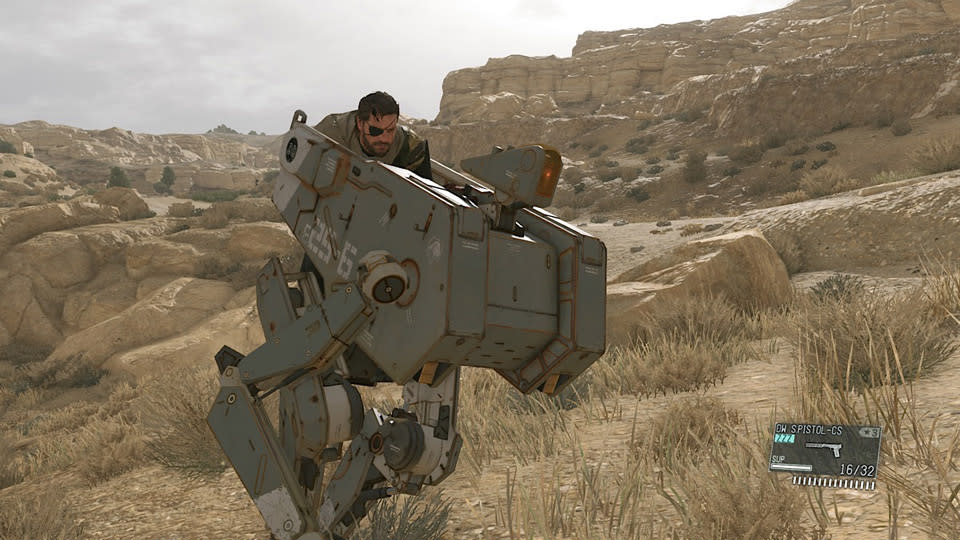
In Metal Gear Solid V: Ground Zeroes, a human bomb sank the dreams and private military corporation of Big Boss, the central figure in Konami's stealth franchise. Metal Gear Solid V: The Phantom Pain continues where we saw the Boss last: hospitalized and disfigured by the bomb blast. The soldier has lost an arm in the chaos and his body has been invaded by over 100 foreign bodies -- a mixture of human teeth and shrapnel -- but the incident seems to have damaged something far more critical: his psyche.
Big Boss' physical transformation leads to changes in his motivation as well. Somewhere between 1984, where The Phantom Pain begins, and 1995, where we meet a rookie soldier named Snake (a genetically-altered clone of the Boss) in the MSX title Metal Gear, Big Boss becomes the franchise's primary villain.
For two days, with a preview build of The Phantom Pain in hand, I tried to uncover the Big Boss' secrets and attempt to learn how a good soldier can go bad.
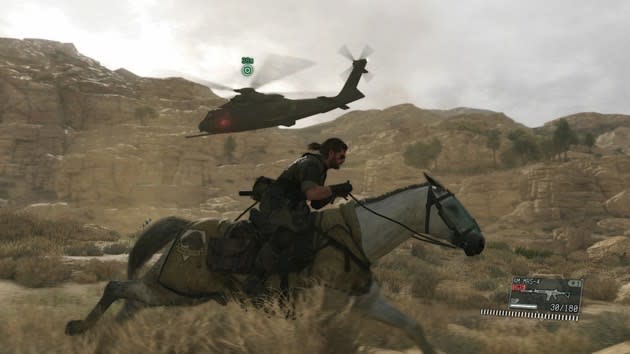
The Phantom Pain has a slow open. Acting as both a reminder of Big Boss's ordeal and a tutorial, the game's protagonist awakens gaunt and feeble after a nine-year coma. He struggles to reactivate his long dormant muscles, spending the majority of the introduction on his belly. It illustrates how far the soldier has fallen from an all-powerful military leader to a weak man struggling to evade danger.
His powerful persona returns after the intro (and after some time has passed) as Metal Gear Solid V: The Phantom Pain leads players to an open-world region of Afghanistan. Imagine a series of large installations, like the one found in Ground Zeroes, surrounded by desert and you'll have an idea of how the map in The Phantom Pain works. It's a massive play area, engulfed in sand, riddled with wildlife and terrorized by the Soviet army.
Big Boss -- back to form and outfitted with an intricate mechanical arm that can be used as a weapon -- quickly establishes himself, alongside familiar franchise characters Revolver Ocelot and Kazuhira Miller, as the leader of a new private military corporation known as the Diamond Dogs. A gun-for-hire in the region, Big Boss helps locals fend off the 1980s-era Soviet invasion of Afghanistan by eliminating their commanding officers, destroying their equipment and generally sowing dissent through the desert.
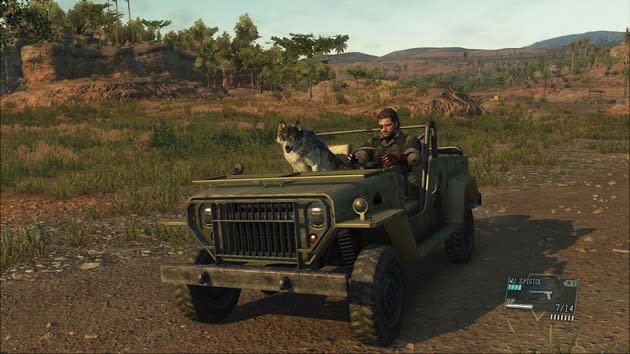
The structure of missions in The Phantom Pain is similar to previous games in the series, specifically Peace Walker and Ground Zeroes. Players are given a slew of missions, some listed as primary story objectives and others as optional Side Ops. Completing Side Ops can be critical if your aim is to make Big Boss' life slightly easier. When he arrives in Afghanistan and holds Soviet soldiers hostage, for example, Boss quickly realizes he doesn't speak the language and can't extract any useful information from the enemies. In an early Side Ops mission, however, Big Boss can capture and recruit a translator, allowing the protagonist to interrogate adversaries for details on enemy positions, special items and more.
The majority of the missions feature simple core objectives. Nearly all of them follow a similar pattern of "Go to place on map; destroy/extract target; get out alive." More story-focused missions offer flavor by way of Metal Gear-level crazy cutscenes, but the objectives tend to bleed together. What you're doing isn't the focus; it's how you're doing it.
When you select a mission, choose your gear and pick your buddy (more on this later), Big Boss decides at what time of day he wants to execute his plan. Infiltrating enemy strongholds at night has its obvious advantages: Darkness means low visibility and fewer guards roaming with a shorter range of view. But your visibility is also at a disadvantage. More than a handful of Soviet soldiers sitting in shadow surprised me as I made my approach, forcing me to drain the batteries of my night vision goggles. Nighttime also means more soldiers resting for the evening indoors, making things complicated when approaching villages with dozens of structures.
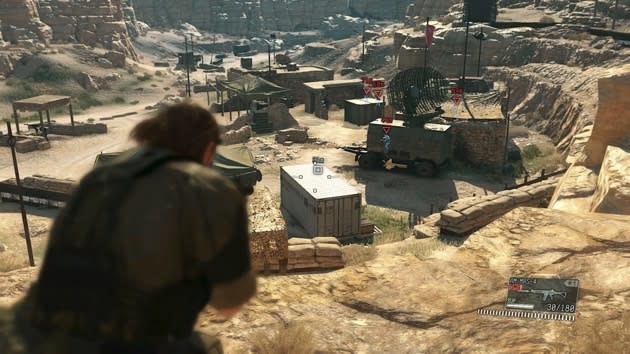
Daylight sneaking offers better visibility -- for you and the Soviets. It's easier to tag and track the movement of enemies from a distance with your advanced binoculars as they roam the desert landscape. But the blinding sunlight can put Big Boss in peril as he waits for his eyes to adjust to the light when transitioning from indoor structures to the desert exterior.
The day-and-night cycle and the game's open-world, "approach from any angle" design gives players an immense sense of freedom and offers healthy mission replayability (you can replay old missions at any time from the main menu). The Buddy system also throws more variety into the mission structure. There are a number of assist characters you can select at the start of each mission. D-Horse can be used to traverse the desert quickly and can be used in stealth (Big Boss leans over to either side of the tamed animal and hugs its side to hide his approach). D-Dog can spot enemies and items in the world as well as distract and attack bad guys. D-Walker is a bipedal robot that Big Boss rides like a minecart that can run at a quick clip on its legs or plod along on wheels for a stealthier approach. Finally there's Quiet, a quick and deadly sniper with a nonsensical fashion sense who can clear your path of any threat with her trusty rifle. Each character offers positive and negative attributes to varying play styles, whether you want to be a stealthy infiltrator or a blood-soaked warlord.
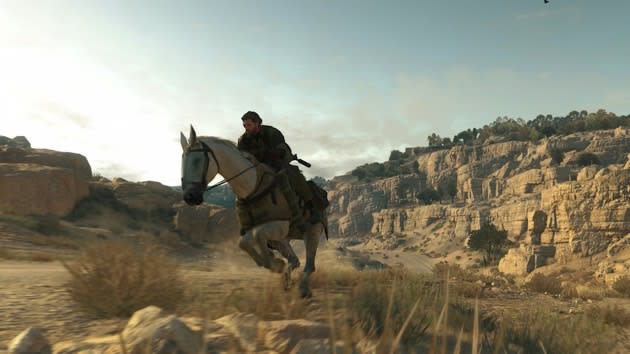
For stealth-oriented players, your aim during missions is to complete objectives and escape unscathed and unseen. Non-stealthy players, though a blasphemous approach for Big Boss, can have just as much fun. The Phantom Pain has a wide swath of deadly weaponry for Big Boss to utilize and gives players some extra reaction time, as previously seen in Ground Zeroes, by slowing time down slightly when detected. This gives players the time to choose, even when detected, whether they want to get aggressive. If things get too hectic, Big Boss can use his iDroid device (sort of a clunky PDA) to radio in for helicopter support. Helicopters can decimate the region with a hail of bullet fire or distract enemies by broadcasting '80s pop music from its speakers. There's something oddly entertaining about taking out a village of bad guys as a helicopter above blasts Kim Wilde's "Kids in America." You can also order a helicopter to drop a crate of supplies (you can select where to drop the crate, including on top of enemy heads!) or call in one of your buddies.
Missions not only expand the story; they feed into The Phantom Pain's metagame. Similar to the PSP game Metal Gear Solid: Peace Walker, Big Boss can recruit enemies into his army by using a device known as the Fulton Recovery System. Essentially, Boss hooks people, animals and objects up to a self-inflating balloon that flies away and lands back at his base (so long as the weather is clear). Back on base, a giant oil rig in the middle of a vast ocean, Snake can catch up with his aggressively recruited army and make changes to the organizational structure of the Diamond Dogs.
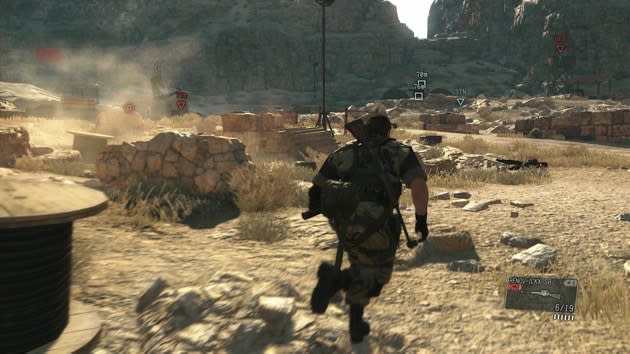
Looking at spreadsheets might not sound like entertainment, but I was quickly enthralled by examining the attributes of my new recruits and manually placing them in different units to expand my army and Big Boss' abilities. The Research & Development unit, for example, can create key equipment for use in the field, such as Big Boss' trusty cardboard box, and upgrades for your buddies. The Intel unit offers more information when Big Boss approaches cities, often pre-targeting enemies and notifying Boss of weather fluctuations (a surprise sandstorm in the middle of an intricate sneaking plan can take things south quickly). There are a handful of other units, but the key to it all is recruitment. I found myself specifically playing in stealth in order to capture and grow my army. There's an additional incentive to the style, similar to Peace Walker.
Eventually you can form combat units and send them on missions for various rewards, like money or new recruits. Your army begins to grow from the inside and you can then take those resources you collect and expand the size and scope of your oil rig. At the end of my two days, my rig featured seven platforms ranging from medical to support all the way to a separate installation for captured animals (however, the zoo is more fun over function).
Though its structure is similar to Peace Walker, this is the first mainline and numbered game in the series that isn't completely focused on narrative. There are none of those classic nearly 30-minute-long cutscenes; instead the game seems to intend for the player to craft their own stories through exploration in the open world. That doesn't mean it always works. The story is disjointed, with most of the nuance tucked away in cassette tapes that players need to stop and listen to. The most drastic difference is how stoic Big Boss is.

My fear was that adding the power of a Hollywood celebrity as the lead's voice would alter how Big Boss interacted with others. Kiefer Sutherland's Snake speaks, but certainly picks his moments. Gone are the days of Snake's two-way radio conversations we hold near and dear to our heart and replaced by a series of returning voice actors that talk at you rather than with you. Here's hoping that Sutherland spouts out some Kojima brilliance later in the game like "La-li-lu-le-lo" -- a codename for Cipher (and The Patriots), the central organization within The Phantom Pain that Boss is investigating. Although the game isn't completely lacking in linear narrative, it's just far different from any other modern, mainline game in the franchise.
At its heart Metal Gear Solid V: The Phantom Pain is a revenge story. Big Boss is looking for a punching bag; he needs someone to blame for taking nine years of his life, destroying his army, killing his allies and taking a piece of his body. In what may very well be his final entry in the series, legendary creator Hideo Kojima gives us a protagonist bent on destroying his adversaries after suffering great loss. There seems like little Big Boss won't sacrifice to be victorious, but as we help him establish his power in The Phantom Pain, we create a future enemy that will terrorize the world of Metal Gear Solid.



























